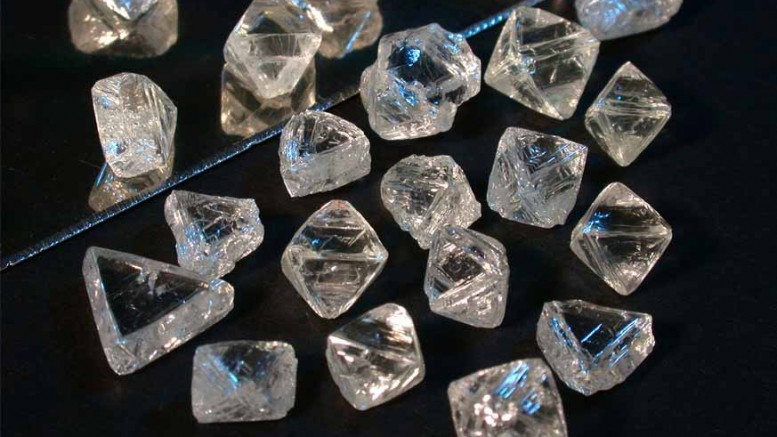As global diversified miners BHP Billiton (BHP-N, BLT-L) and Rio Tinto (RTP-N, RIO-L) look to step out of the diamond business, a third, Anglo American (AAL-L), is diving in deeper.
In early November, Anglo announced an agreement to buy the Oppenheimer family’s 40% interest in De Beers for US$5.1 billion. That purchase will add to Anglo’s current 45% stake in De Beers to give it up to 85% of the world’s largest diamond producer by value.
In a press release, Anglo chief executive Cynthia Carroll outlined the rationale for the investment in the diamond miner and retailer with the “iconic brand.”
“This transaction is a unique opportunity for Anglo American to consolidate control of the world’s leading diamond company — De Beers,” she said. “Today’s announcement marks our commitment to an industry with highly attractive long-term supply and demand fundamentals.”
Anglo says De Beers now has a streamlined portfolio after selling off some of its smaller-scale, late-life assets.
Carroll also said the purchase would benefit De Beers and that the simplified ownership structure would enhance the company’s performance.
“Anglo American is well positioned to enhance the value of De Beers through its expertise and scale in such areas as technical, supply chain and financial management functions as part of a simplified and more integrated ownership structure.”
The government of Botswana, which currently holds 15% of De Beers, has the right to increase its ownership to 25%. If it chooses to exercise that right, it will pay the Oppenheimer family’s holding company CHL Group its proportional share of the purchase price.
At presstime, the purchase had won the approval of Anglo shareholders, and of European Commission and South African regulators. The sale isn’t expected to close until the second half of 2012.
The exit of the Oppenheimer family from the diamond powerhouse it played a profound role in shaping is historic.
“This has been a momentous and difficult decision as my family has been in the diamond industry for more than 100 years and part of De Beers for over 80 years,” Nicky Oppenheimer, chairman of De Beers, said in a press release. “Anglo American is the natural home for our stake as they have been major shareholders in De Beers since 1926 and have a deep knowledge of the diamond business.”
The Oppenheimer’s exit from diamonds wasn’t a complete surprise. But many in the industry feel the purchase could result in big changes at De Beers — with some speculation that it could ditch its sightholder system. Under that system, buyers cannot select diamonds for purchase — they must either accept or reject the selection of diamonds offered to them.
Charles Wyndham, founder of PolishedPrices.com told The Northern Miner in November that the Anglo purchase is good news for the industry.
“Oppenheimer is clinging to an outdated business model and hopefully the purchase by Anglo American, in combination with the new chief executive, Frenchman Philippe Mellier, is going to allow for significant change,” Wyndham said.
Mellier, an outsider to the diamond industry who was a surprise appointment as CEO of De Beers last year, is a former auto industry executive.
Anglo has given no clear indications of what shifts in direction, strategy or operations, if any, would follow its assumption of majority control in De Beers.
Tom Ormsby, De Beers Canada’s director of external and corporate affairs, says that any changes won’t be apparent until after the sale closes.
He also points out that not only is Anglo already De Beers’ largest shareholder, but the two companies have a long history together.
“Anglo was actually founded by the Oppenheimer family 80 years ago, so there’s always been participation in the De Beers family with the Anglo family,” Ormsby says. “They’ve always been intertwined — the DNA is almost identical.”
The companies have also shared senior staff, he says, adding that the first thing that will be noticeable for De Beers, once the sale is complete, will be the opportunity to tap into Anglo’s vast and varied expertise and resources on a larger scale.
“Accessing that really strong resource pool, both intellectual capital and financial capital, is going to probably be the first thing we’ll be able to see as a change for us.”
De Beers Canada contributes about 5% of the company’s overall production from the Snap Lake mine in the Northwest Territories and the Victor mine, in northern Ontario. Snap Lake has a 20-year mine life ending in 2028, while the company is working on extending Victor’s mine life, which currently runs to around 2020. It’s also in the permitting process at its 51%-owned Gahcho Kue project, a joint venture with Mountain Province Diamonds (MPV-T) in the Northwest Territories with an expected mine life of 10 years.
Anglo expects the purchase to be accretive to underlying earnings before depreciation and amortization. The purchase price is about 25% lower than RBC Capital’s valuation of De Beers.
The move will give diversified miner Anglo more exposure to late-development cycle commodities (which include platinum and petroleum), demand for which is projected to skyrocket once developing countries such as China and India reach a certain stage of economic prosperity.
In a conference call after the announcement, Anglo CEO Carroll would not comment on whether De Beers would be looking at buying up assets to replace production, or on the possibility of an IPO for De Beers. But speculation about an IPO predates the Anglo announcement. Under the agreement with the Oppenheimer family, Anglo would have to compensate the Oppenheimers for any increased value an IPO would bring if a listing happens within two years of the deal’s completion (10% of the increase in attributable value if it occurs within two years, or 20% if it occurs within on year).
The diamond miner and retailer is just coming off a very successful 2011, with strong demand combined with the rise in rough diamond prices last year helping to push up its pretax profits by 48% over the previous year to US$1.27 billion. “Exceptional” consumer demand, which jumped by around 12% in 2011, resulted in De Beers second-strongest year ever for sales at US$6.5 billion. The company doesn’t expect growth in 2012 to be as robust, but believes it will still be a positive year. Production for the year was down by 5% to 31.3 million carats due to a variety of factors, including heavy rain in South Africa, lengthy labour negotiations and maintenance backlogs.
Another transition that De Beers is currently completing is a shift its diamond selling offices from London to Botswana by the end of 2013. The company made a deal with the government, its 15% shareholder to move the operations there in return for a 10-year contract for sorting, valuing and selling diamond production from Debswana, a joint venture of De Beers and the Botswana government.




Be the first to comment on "Anglo takes the reins at De Beers"